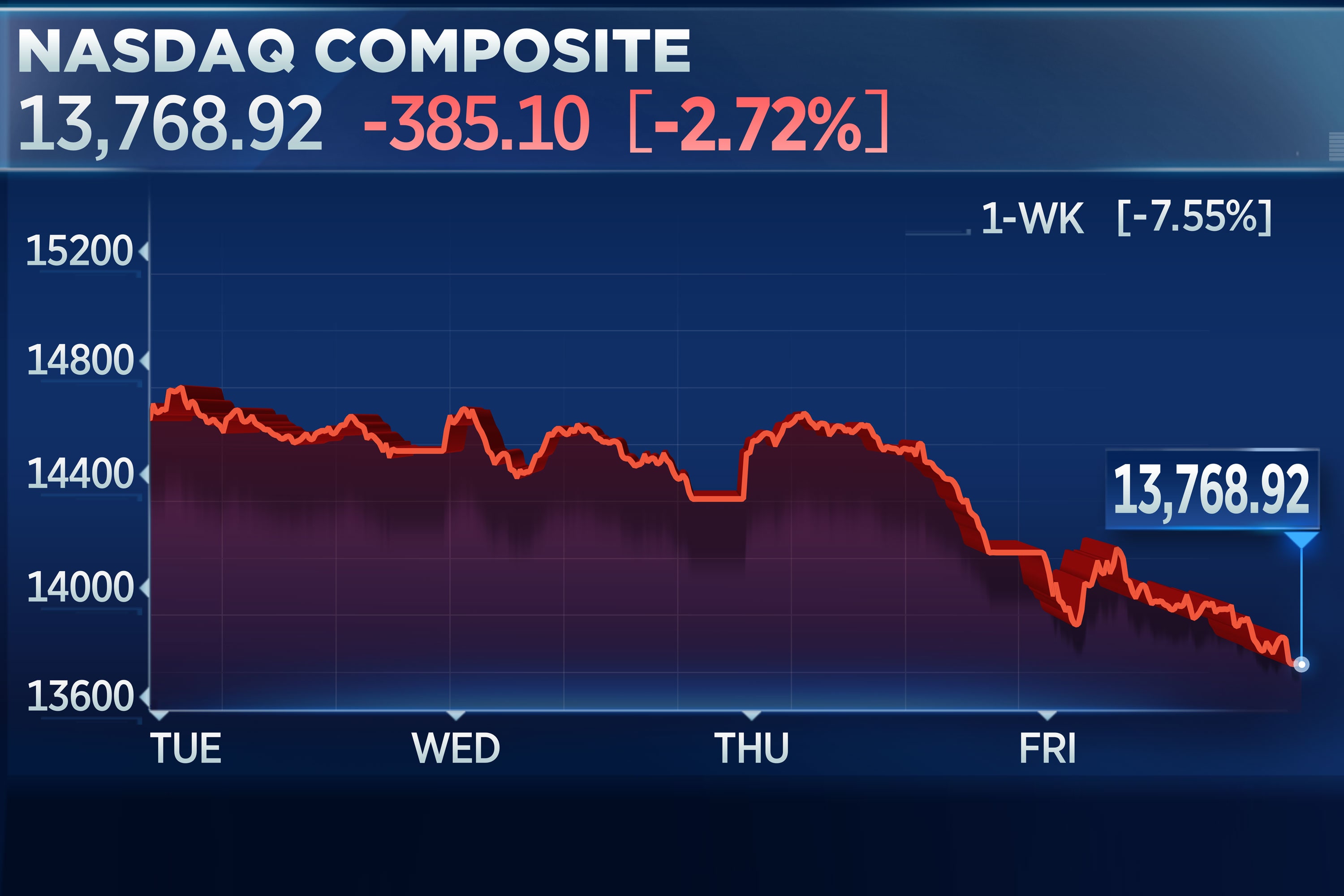Stocks extend losses in final hour of trading, Nasdaq down nearly 2%

The Nasdaq Composite dropped on Friday, on pace for its worst week since 2020, as sharp losses in streaming giant Netflix dragged the technology-focused index deeper into correction territory.
The Nasdaq Composite declined about 1.9%. The Nasdaq is down more than 7% since Monday, track for its worst week since October 2020. The Dow Jones Industrial Average fell about 350 points. The S&P 500 was down roughly 1.3%. Both the Dow and S&P 500 are on track for a third straight week of losses.
Netflix‘s disappointing quarterly report is the latest setback for technology investors. Shares of the streaming giant tumbled 23% on Friday after the company’s fourth-quarter earnings report showed a slowdown in subscriber growth. Its competitors’ shares also declined, with Dow component Disney, which operates the Disney+ streaming service, off 7%.
Netflix is the first major tech stock to report earnings this season, with Apple and Tesla slated to post earnings next week. Tesla lost nearly 4% on Friday. Other tech names like Amazon and Meta Platforms fell 3.6% and 2%, respectively.
Meanwhile, Peloton shares rebounded 10% on Friday. The maker of interactive fitness bicycles and treadmills plunged 23.9% during regular trading on Thursday after CNBC reported that the company is temporarily halting production of its fitness products.
The major losses in growth names have pushed the Nasdaq Composite further in correction territory as rising rates pressure technology stocks by making their lofty valuations look less attractive. Nearing Friday’s close, the Nasdaq was down more than 13% from its closing record in November.
The Nasdaq is off to its worst start to the year, through the first 14 trading days, since 2008, according to FactSet.
“Given the emotional decline in the stock market of the last few days, fundamentals have been suspended as market action is entirely tied to technical support levels,” said Jim Paulsen, chief investment strategist at Leuthold Group.
“Until a level is reached in this collapse… fundamentals like bond yields, economic reports and even earnings releases will not likely have much impact. Fear now must be extinguished by some stock market stability before traders and investors again start to consider fundamental drivers,” added Paulsen.
The Nasdaq Composite’s struggle is largely due to a surge in government bond rates this week. The U.S. 10-year Treasury hit as high as 1.9% on Wednesday as investors focused on the Federal Reserve’s timeline for raising interest rates and broadly tightening monetary policy. However, bond yields retreated on Friday.
Investors will now be turning their attention to the Fed’s January two-day policy meeting, set to start on Tuesday.
“While a handful of rate hikes over the next year or two would represent a shift in Fed policy, we wouldn’t consider policy restrictive and we don’t expect the initial rate increase to derail the economic recovery,” said Scott Wren, senior global market strategist at Wells Fargo Investment Institute. However, he added that rate hikes will inject volatility into the market.
During regular trading Thursday, the Dow shed 313 points, or 0.89%. At one point during the session, the 30-stock benchmark was up more than 450 points. A similar reversal played out for the other major averages. The S&P declined 1.1% after earlier advancing 1.53%. The Nasdaq Composite ended the day with a loss of 1.3%, reversing a prior move that had the tech-heavy index up 2.1%.
U.S. stocks this month have often sold off into the close. The S&P 500 on average has fallen 0.16 percentage points in the final hour of trading in January, according to Bespoke Investment Group analysis through Wednesday. That average last-hour performance places January in the bottom 1% of all months and third-worst since 2000, Bespoke found.
Small caps have also been hit hard this week. The Russell 2000 is on track for its worst week since June 2020. The index fell 1.4% on Friday.
Bitcoin is getting hit hard on Friday as investors brace for the Fed and dump riskier assets with higher rates ahead. The digital asset fell more than 10% to around $38,233 on Friday.
– CNBC’s Patti Domm contributed reporting.




